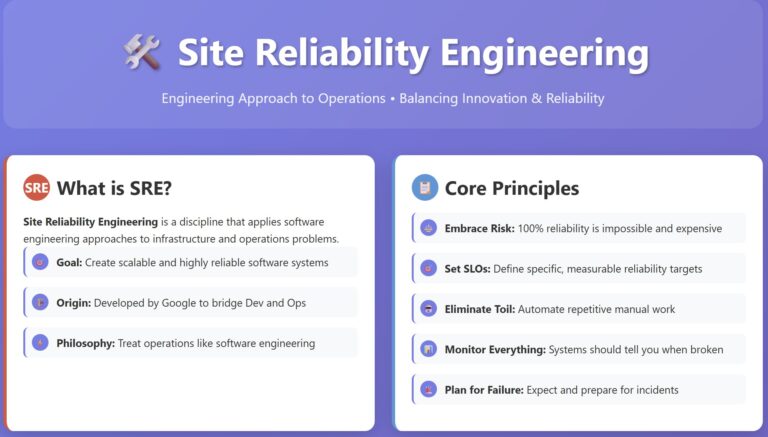🛠️ Site Reliability Engineering
Engineering Approach to Operations • Balancing Innovation & Reliability
SREWhat is SRE?
Site Reliability Engineering is a discipline that applies software engineering approaches to infrastructure and operations problems.
📋Core Principles
📈The SLI → SLO → SLA Flow
SLIs
Service Level Indicators
What we measure
•
Availability
• Latency
• Error Rate
SLOs
Service Level Objectives
What we target
•
99.9% uptime
• <200ms response
• <0.1% errors
SLAs
Service Level Agreements
What we promise
•
External contracts
• Customer guarantees
• Business
commitments
🎯 Error Budget Concept
If SLO = 99.9% availability, then Error Budget = 0.1% downtime allowed
Green Zone: Fast innovation • Red Zone: Focus on stability
⚙️Key Practices
🔍 Four Golden Signals
Latency
Request processing time
Traffic
System demand
Errors
Failed requests
Saturation
Resource utilization
🛠️Popular SRE Tools
🚀 SRE Implementation Roadmap
Assess Current State
Evaluate existing reliability practices, metrics, and incident handling processes
Define SLIs & SLOs
Identify key user-facing metrics and set realistic reliability targets
Build Monitoring
Implement comprehensive monitoring and alerting for your SLIs
Establish Incident Response
Create structured processes for handling and learning from incidents
Automate Toil
Identify and eliminate repetitive manual tasks through automation
✨Benefits of SRE
🏢 SRE Team Models
Embedded
SREs work within product teams
Centralized
Dedicated SRE team serves multiple products
Consulting
SRE experts help establish practices
Hybrid
Combination of multiple approaches
🎯 Remember: SRE is a Journey, Not a Destination
Start where you are • Use what you have • Do what you can
Focus on user experience, embrace data-driven decisions, and continuously improve your systems and practices.


